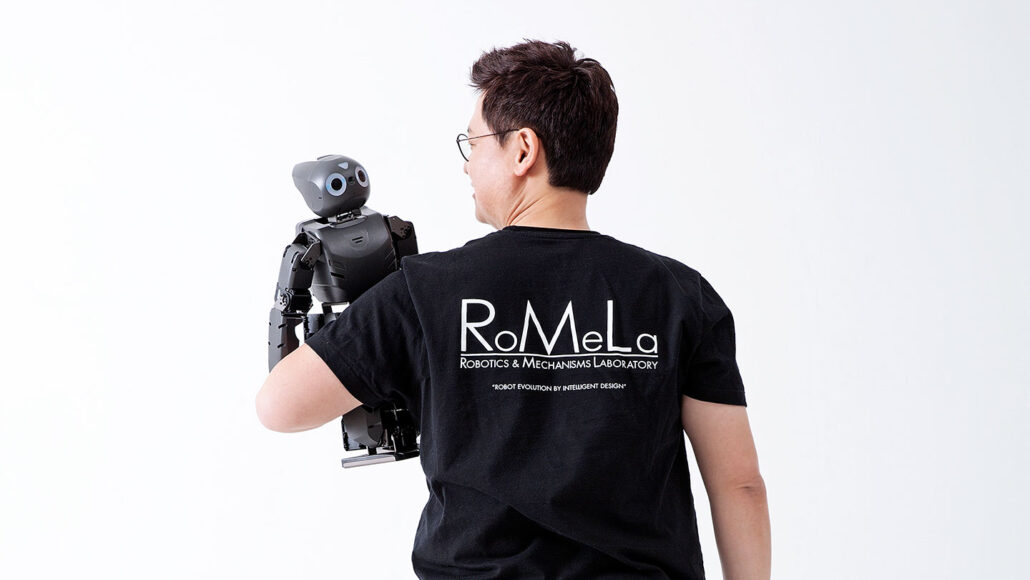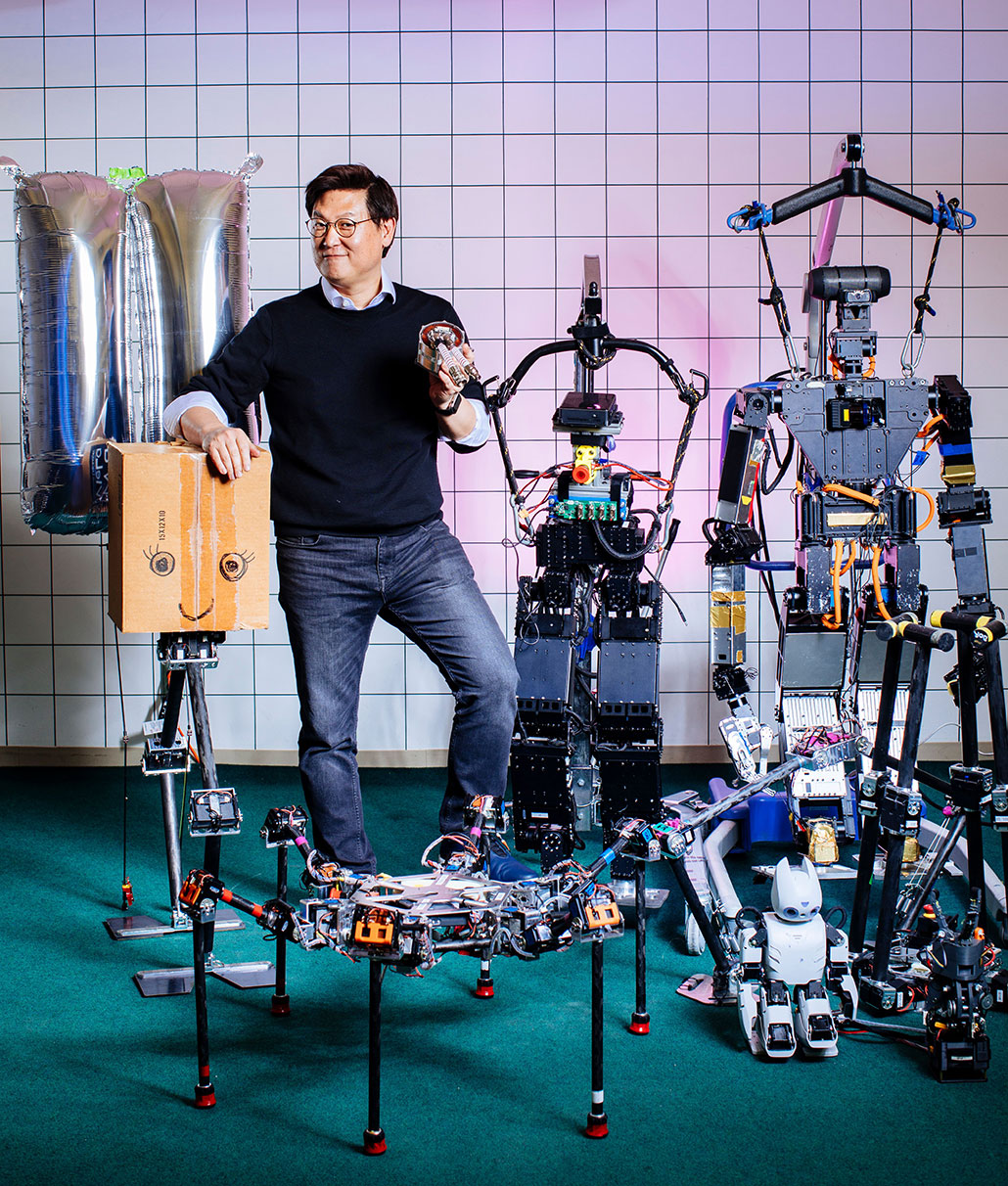Magic, cooking and droids inspire this roboticist
Dennis Hong builds robots that help solve problems — and entertain

Failure is a necessary step, says roboticist Dennis Hong (with his humanoid robot DARwIn-OP). “If you’re too afraid of failure, then you only get to walk on the safer side [and] then there’s no innovation.”
ROBOTICS & MECHANISMS LABORATORY/UCLA
One day, you may get to try food prepared by a robot — and it just might be one invented by Dennis Hong.
Hong is a roboticist and the founding director of the Robotics and Mechanisms Laboratory (RoMeLa) at the University of California, Los Angeles. Hong and his graduate students at the UCLA Samueli School of Engineering study how robots move. They also design human-like robots. This includes a cooking robot called Project YORI. His team wants YORI to be able to cook an entire menu of food. “Just yesterday, [YORI] cooked steak frites, or steak and french fries,” says Hong.
YORI is only the latest of Hong’s robot inventions. There’s DAVID, the world’s first and only car that can be driven by the blind. And SAFFiR, a two-legged robot designed to extinguish fires on Navy ships, to name a couple. Robots, Hong notes, are intelligent machines that do the work humans are often unable or unwilling to do. And Hong is finding plenty of work for his robots. In this interview, Hong shares his experiences and advice with Science News Explores. (This interview has been edited for content and readability.)
What inspired you to pursue this career?
When I was seven years old, I watched Star Wars: Episode Four [A New Hope] for the first time. In the movie, there are two robots they call droids. Everybody knows R2-D2 — the one that looks like a trash can — and the humanoid robot, C-3PO. I was so mesmerized by those two robots. On my way back home in the car, I told my parents that I was going to become a robot scientist. I think, subconsciously, those two droids influenced me, and you can see it in the robots that we are creating.
How did you get to where you are today?
As a kid, I didn’t know a lot about robots. I only knew what I saw from science fiction movies. As I became older, I started to learn what engineering actually is. When I was in elementary school, I hated math. I got all A’s in science, but my math score was really low. My father — an aerospace engineer — told me that engineers solve problems in the world by using science as a tool and mathematics as a language. Even though I did not like math, he helped me realize that I had to study harder to follow my dream of becoming a roboticist.
How do you get your best ideas?
Ideas come from everywhere and at any time. Our three-legged robot STriDER is a fantastic example. It flips its body to walk and is inspired by nature. We call this biomimicry or bio-inspired robotics. But have you seen anything in nature that has three legs? Even though it doesn’t look like anything found in nature, this robot actually moves like humans. We studied how humans walk and used what we learned to build it.
The idea came to me when I was a graduate student. I would often go to a nearby park to clear my mind. One time, I saw an elderly lady braiding somebody’s hair. This was my first time actually seeing how it was done. You have three strands of hair, and then you put one strand through the other two. I was not thinking about robotics at all, but I always carry a pencil and notebook. When I see something interesting, I make sketches and notes. I sketched the process of braiding hair. I thought I could maybe use it to make a toy or a puzzle.
Ten years later, the U.S. Navy contacted me about designing a robot that could move along the shoreline. I took out my idea notebooks and started flipping through them. Voila! I found my sketches of braiding hair. Suddenly, the hair started to look like legs. I ended up designing the three legs after braided hair.
What is one of your biggest successes when it comes to your career?
The biggest product of our lab is really our students. I’m proud whenever I hear news about our students doing great things all over the world.
If I had to choose a project, it would be the robot called DARwIn-OP. It’s one of the most widely used humanoid robots for research and education. We made it completely open source. That means that we made the software and instructions on how to build it free for anyone to use. Many new types of robots have also been built based on its design. When I go to international robotics conferences, I see so many projects using DARwIn’s design. I consider it a gift to the robotics community.
What was one of your biggest failures and how did you get past that?
People on social media are eager to see our inventions. But many only want to see our successes and not the failures that came before those. Failure is simply a stepping stone when developing new technology for our lab.
If we have a student who has never failed, then that’s not a good thing. That means that he or she really hasn’t tried hard enough to push the limits. I tell my students to try to push their robots to their limits. I tell my students to literally try breaking the robot. If the robot doesn’t fall and doesn’t break, we don’t get to learn anything.
There’s a saying that failure is not an option. But failure is actually a necessary step to success. If you’re too afraid of failure, then you only get to walk on the safer side. And if you walk on the safer side, then there’s no innovation. One of the most important things in our lab is that we accept failure.

What do you like to do in your spare time?
My son is my best friend. We break things, we fix things, we climb trees — we do everything together. So that’s my joy. I’ve also consulted with various theme park rides and museum exhibits. I’m a pretty serious gourmet chef. I cook every day at home. I was on the cooking competition, Master Chef USA. Chef Gordon Ramsay tasted my food and called me brilliant. Then he eliminated me. There are not a lot of people who are both a chef and a roboticist. Maybe this led me to work on the cooking robot YORI.
I am also an amateur magician. I started as a kid with a basic magic kit my Dad bought me. I read books about magic and created my own tricks. I would perform at retirement homes and orphanages. I was even on TV a few times.
There’s a Netflix series by a famous magician named Justin Willman called Magic for Humans. For one episode, he came to our lab to learn about robotics. He challenged us to build a magic-performing robot in two weeks. So we designed and built our robot MAGI. We had a magic contest between the world-famous magician and our robot.
My job and these hobbies of mine share a common theme. They’re all about giving people happiness. Robots can do things that people don’t want to do. Cooking food lets you share your love with family and friends with yummy food. Magic tricks and theme parks entertain people. I am most happy when I try to make other people happy. I think that’s my whole life’s purpose.







